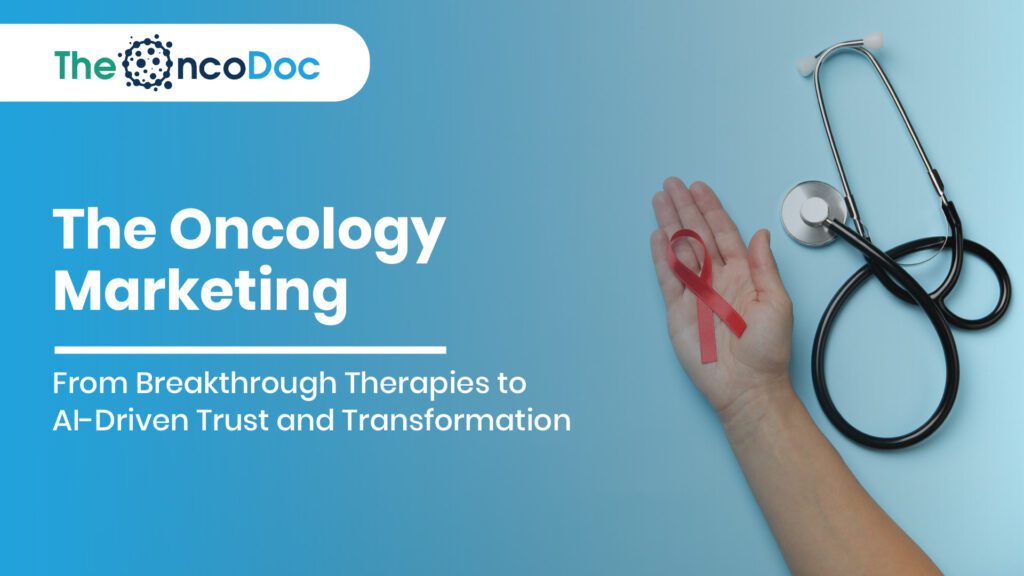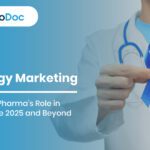Introduction
Oncology pharma marketing is entering a defining moment in its evolution. Once anchored in product promotion and physician outreach, the discipline is now transforming into a multidimensional ecosystem that blends scientific rigor, digital intelligence, and human empathy. The catalyst for this transformation lies in three converging forces: the unprecedented pace of therapeutic breakthroughs, the integration of artificial intelligence and real-world data into every aspect of commercialization, and the rising expectation of patient-centricity across the healthcare spectrum.
Global oncology spending is projected to exceed USD 900 billion by 2034, underscoring both the opportunity and the challenge for pharmaceutical companies. While innovation pipelines deliver therapies of remarkable sophistication, CAR-T, bispecific antibodies, and cancer vaccines, stakeholders are demanding more than clinical efficacy. Payers seek cost-effectiveness, oncologists require hyper-personalized evidence, and patients insist on transparent, empathetic engagement that respects their lived experience.
This new reality means oncology marketing must pivot away from broad campaigns and one-size-fits-all strategies. Instead, the future belongs to precision-driven approaches that can segment patient groups, anticipate regional cancer trends, and personalize digital touchpoints across the care journey. Companies must simultaneously manage ethical challenges, such as regulatory monitoring of expedited approvals and the fine line between responsible storytelling and direct-to-consumer communication.
This report delves into the five pillars shaping the future of oncology pharma marketing: market dynamics and therapeutic innovation, digital transformation through AI and data, patient-centric engagement models, regulatory and ethical landscapes, and strategic stakeholder outreach. By examining these interconnected drivers, the report provides a strategic blueprint for oncology marketers to move beyond transactional promotion and towards sustainable, evidence-driven impact, where success is measured not by prescriptions written, but by lives improved and trust earned.
1. The Macro-Environment: Market Growth and Therapeutic Innovation
1.1 Oncology Market Dynamics
The oncology sector continues to expand at an unprecedented pace. The market is anticipated to develop at a 10–12% CAGR during the next ten years, surpassing USD 356 billion by 2025. The U.S. alone will account for nearly USD 417 billion by 2034, consolidating its dominance.
Key Growth Drivers:
- Rising global cancer incidence (projected 77% increase by 2050).
- Accelerated R&D investments in immunotherapies, CAR-T, and bispecific antibodies.
- Use of real-world evidence techniques and digital oncology technologies.
- Growing patient demand for personalized, accessible therapies.
Yet, innovation comes at a steep cost. Because treatments like CAR-T can cost up to USD 400,000 per patient, payers are scrutinizing them more than ever before. Marketing narratives must now emphasize value beyond efficacy, showcasing quality of life improvements, reduced hospitalizations, and long-term savings.
1.2 The New Therapeutic Renaissance
The oncology pipeline is rich with next-generation modalities:
- Bispecific antibodies redefining immuno-oncology benchmarks.
- Synthetic lethality approaches introducing precision pathways for resistant cancers.
- Protein degraders and RNA-based therapeutics offering novel mechanisms.
- Cancer vaccines and gene therapies maturing into commercial realities.
Each innovation introduces complexity in communication. Unlike chemotherapy, which had broad applications, modern therapies are biomarker-specific. This requires marketers to adopt hyper-segmented campaigns, targeting distinct patient subsets while educating HCPs on nuanced mechanisms of action.
2. The Digital Transformation: AI, Data, and Tele-Oncology
2.1 AI as the Engine of Commercial Agility
AI provides flexibility throughout the business chain, from identifying trial participants to forecasting local cancer peaks. From identifying trial participants to predicting regional cancer surges, AI creates agility across the value chain.
Applications in Pharma Marketing:
- HCP Targeting: Predictive models identify high-value oncologists likely to adopt new therapies.
- Content Personalization: Generative AI creates compliant, tailored messaging aligned to physician or patient needs.
- RWD Analytics: AI converts real-world datasets into actionable insights for payers, regulators, and marketers.
One leading case study demonstrated a 50% faster turnaround in trial matching using AI-driven patient record analysis, generating USD 50 million in annual partnership value.
2.2 Digital Health and Tele-Oncology
Telemedicine, once pandemic-driven, has become a permanent oncology care channel. With 90% patient satisfaction rates, telehealth reduces barriers in rural and underserved regions.
Pharma companies are embedding themselves in these digital ecosystems by:
- Sponsoring virtual tumor board webinars for oncologists.
- Integrating educational modules into tele-oncology platforms.
- Using digital biomarkers from wearables to enhance long-term patient engagement.
3. The Patient-Centric Mandate
3.1 From Patient Engagement to Shared Decision-Making
Patients are no longer passive recipients but active co-decision-makers. Oncology pharma marketing must align with shared decision-making models, where trust is built through education, empathy, and transparency.
Strategies include:
- User-friendly decision aids tailored to literacy levels.
- Survivor-led digital storytelling campaigns (40% higher engagement rates).
- Multilingual, culturally sensitive content for underserved populations.
3.2 Patient-Reported Outcomes (PROs)
PROs are emerging as strategic differentiators in market access. Beyond survival rates, payers and regulators are demanding evidence of quality of life improvements.
For example, in therapies with similar efficacy, the drug associated with better fatigue or pain management scores may secure preferential formulary placement.
4. Navigating the Regulatory and Ethical Landscape
4.1 Ethical Boundaries of Oncology DTC Marketing
Direct-to-consumer (DTC) promotion in oncology remains contentious. While it empowers patients, it risks overemphasizing exceptional outcomes.
Regulatory bodies like the FDA mandate fair balance messaging, ensuring risks are communicated alongside benefits. Future-proof oncology campaigns will shift from drug-centric ads to ecosystem education, focusing on patient journeys and preventive care.
4.2 Accelerated Approval Reforms
Confirmatory trials must now be actively enrolling at approval, under FDA’s FDORA 2022. Marketers must adjust strategies accordingly, embedding long-term transparency into brand narratives.
This means oncology launches are no longer one-off events but multi-year evidence campaigns, continuously updated as confirmatory trial data emerges.
5. Strategic Go-to-Market Models
5.1 Engaging Healthcare Professionals (HCPs)
Physician time scarcity demands precision outreach. Successful strategies blend:
- AI-personalized digital content (short videos, decision-support tools).
- Omnichannel engagement combining virtual webinars with in-person CME.
- KOL-driven narratives to build credibility within peer groups.
5.2 Payer Engagement as a Core Pillar
Payers hold unprecedented influence. Oncology marketing must shift from efficacy-led pitches to HEOR-driven value propositions.
Effective strategies include:
- Budget impact models for therapies vs. hospitalization costs.
- Comparative effectiveness data to highlight differentiation.
- Early engagement with payer advisory boards.
5.3 Institutional and Patient-Level Campaigns
Pharma brands must simultaneously build trust at the institutional level (cancer centers, hospitals) and direct patient support ecosystems.
Tactics include:
- Sponsoring digital patient communities for survivorship care.
- Collaborating with NGOs and government health missions for mass screenings.
- Supporting post-treatment wellness programs (nutrition, mental health, rehabilitation).
6. Precision Omnichannel Marketing in Oncology
Oncology is inherently complex, and so is the information ecosystem around it. Patients, oncologists, and payers consume knowledge in fragmented, channel-specific ways. Unlike consumer marketing, pharma marketing requires scientifically validated, compliance-safe omnichannel strategies.
Trends Shaping Precision Omnichannel:
- Integrated Digital Journeys: Seamless content delivery across social media, HCP portals, tele-oncology platforms, and in-clinic kiosks ensures consistent messaging.
- Micro-segmentation by Audience Type: An oncologist in a Tier-1 hospital may prefer peer-reviewed webinars, while a patient caregiver may respond better to Instagram-based survivor stories.
- AI-Powered Orchestration: AI platforms now manage channel sequencing (e.g., push a patient educational video after a chatbot interaction, or trigger a KOL webinar invite after a physician downloads trial data).
A McKinsey analysis shows that omnichannel orchestration increases oncology campaign engagement rates by up to 45%, especially when emotional content is blended with clinical data.
7. Real-World Evidence (RWE) as a Marketing Differentiator
In an era where payers and regulators demand value beyond trial data, Real-World Evidence (RWE) has become central to oncology pharma marketing. Clinical trials often operate under idealized conditions, while RWE demonstrates how therapies perform in diverse patient populations and care settings.
Key Marketing Applications of RWE:
- Payer Negotiations: Budget impact models using real-world hospitalization data strengthen reimbursement discussions.
- Physician Engagement: HCPs are increasingly influenced by peer-relevant local outcomes, not just global trial data.
- Patient Confidence: Sharing anonymized real-world survivorship stories builds trust and credibility.
For instance, an RWE-based campaign showed that a new immunotherapy reduced hospitalization costs by 22% in real-world lung cancer patients. This not only resonated with payers but also reassured physicians of system-level value.
8. The Rise of Digital Twins and Predictive Oncology
A digital twin, a virtual patient replica built on genetics, biomarkers, and lifestyle data, is becoming a frontier innovation in oncology care and marketing. Pharma companies are experimenting with digital twin models to simulate therapy outcomes, optimize trial design, and demonstrate predictive efficacy.
Marketing Implications:
- Personalized Simulations for Oncologists: Instead of static graphs, HCPs can visualize therapy outcomes on digital twin models, making the treatment narrative more persuasive.
- Patient Empowerment Tools: Patients can see how therapies might affect “someone like them,” creating empathy-driven adoption.
- Market Differentiation: Brands that integrate digital twins into campaigns position themselves as future-ready innovators.
By 2030, Gartner predicts that 25% of healthcare organizations will deploy digital twin technologies, fundamentally reshaping oncology marketing from reactive education to predictive engagement.
9. Emotional Intelligence (EI) in AI-Driven Campaigns
While AI dominates oncology marketing, the next leap forward is AI infused with emotional intelligence. Oncology is one of the most emotionally charged therapeutic areas, fear, hope, anxiety, and resilience coexist in patient and caregiver journeys.
How EI-Driven AI is Reshaping Marketing:
- Sentiment-Adaptive Messaging: Algorithms that analyze tone in patient forums can shift campaign language from “clinical” to “comfort-driven.”
- Emotionally Aligned Chatbots: Instead of robotic scripts, oncology chatbots can deliver empathetic reassurance, improving patient trust.
- Campaign Risk Management: EI analytics can detect when campaigns unintentionally trigger fear or misinformation, enabling real-time corrections.
A Harvard Business Review study showed that emotionally resonant campaigns drive 2.5x higher patient engagement compared to purely informational ones. For oncology, where fear is a barrier to screening and treatment, empathy is as critical as evidence.
10. Sustainability and ESG in Oncology Pharma Marketing
Oncology pharma companies are increasingly evaluated not just by clinical outcomes but also by their societal and environmental impact. Patients and payers are now considering ESG (Environmental, Social, and Governance) commitments when choosing trusted brands.
Sustainability-Linked Marketing Tactics:
- Eco-Friendly Patient Kits: Using biodegradable materials for medication packaging and educational booklets.
- Green CME Conferences: Sponsoring hybrid medical congresses that reduce travel emissions.
- Social Impact Campaigns: Funding rural cancer screening camps as part of corporate social responsibility (CSR) and integrating them into brand narratives.
For oncology, ESG is more than corporate reputation, it directly influences trust and patient alignment. A survey revealed that 61% of patients and caregivers trust pharma brands more when they demonstrate community-level social commitments.
Conclusion: Charting the Next Decade of Oncology Pharma Marketing
Oncology pharma marketing in 2025 and beyond is a convergence of science, technology, and humanity. The traditional walls separating R&D, commercial, and patient engagement are dissolving into a data-first, empathy-driven ecosystem.
The expanded analysis highlights ten imperatives that will define oncology’s commercial future:
- Harness AI for precision omnichannel orchestration.
- Use Real-World Evidence as a marketing differentiator.
- Integrate digital twins to personalize and predict patient outcomes.
- Infuse campaigns with emotional intelligence to build deeper trust.
- Anchor marketing strategies in sustainability and ESG values.
- Advance shared decision-making models with patients and caregivers.
- Use HEOR and PRO-driven tactics to show payer-centric value.
- Build tele-oncology ecosystems where marketing blends seamlessly into care.
- Prioritize scientific transparency in accelerated approval and regulatory environments.
- Shift from product promotion to holistic survivorship engagement.
The future of oncology pharma marketing will be measured not by short-term prescription uptake, but by long-term patient survival, trust in innovation, and system-wide value creation. Companies that master the delicate balance of scientific rigor, digital intelligence, and human empathy will not only thrive commercially but also reshape the global fight against cancer.
The Oncodoc team is a group of passionate healthcare and marketing professionals dedicated to delivering accurate, engaging, and impactful content. With expertise across medical research, digital strategy, and clinical communication, the team focuses on empowering healthcare professionals and patients alike. Through evidence-based insights and innovative storytelling, Hidoc aims to bridge the gap between medicine and digital engagement, promoting wellness and informed decision-making.



